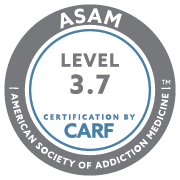There are many harsh realities to face when you’re dealing with substance use disorder. For some, it’s living with their own guilt and shame; for others, it’s bearing somebody else’s. However, there’s one burden that is perhaps one of the most difficult to bear, and that’s when women are hurt by both domestic and substance abuse. There is a way to break the patterns with professional treatment and services.
What is Domestic Violence?
Domestic violence is abusive behavior used for intimidation, power, and control that becomes a pattern in a relationship. This behavior is terrifying to anybody on the receiving end, but what’s even worse is when it is multiplied tenfold. When those who are committing domestic abuse are also suffering from a substance use disorder, the violence can spiral into something far worse and more dangerous than anybody could anticipate.
 On the other side of the coin, there are other potential dangers when it comes to this sort of double trouble. When individuals are abused or being treated poorly by their partner or loved one, there are possibilities in which the person falls into substance abuse themselves. When it comes to women who have been abused, they’re anywhere between 9 and 15 times more likely to abuse drugs or alcohol than those who aren’t abused.
On the other side of the coin, there are other potential dangers when it comes to this sort of double trouble. When individuals are abused or being treated poorly by their partner or loved one, there are possibilities in which the person falls into substance abuse themselves. When it comes to women who have been abused, they’re anywhere between 9 and 15 times more likely to abuse drugs or alcohol than those who aren’t abused.
It’s difficult to cope with someone you love hurting you physically, but physical violence is not always the way people are hurt; there are many other ways that an individual can be on the receiving end of domestic abuse, some of which include the following:
- Emotional abuse
- Psychological abuse
- Sexual abuse
- Verbal abuse
- Social abuse
- Financial abuse
Signs That You Are Being Abused
There are many signs that can point towards someone being an abuser or the victim of one, some of which include, but are not limited to the following:
- Someone being told they can’t do anything right
- Controlling the way an individual dresses
- Not allowing an individual to see family members
- Not being able to make decisions for one’s self
- Being intimidated or threatened by your partner
- Forcing someone to do something they don’t want to do
- Manipulating your partner
- Embarrassing, insulting, or shaming your partner
Domestic Abuse and Addiction
of cases of domestic violence are linked to drugs or alcohol in some way or another.
Women are between
more likely to abuse substances than those who haven't been abused
men admitted to using substances before committing an act of violence
Signs of Substance Use Disorder and Domestic Violence
Shame
Denial
Losing Control
Consistent Abusive Behavior
The Link Between Domestic Violence and Substance Abuse
Close to 80% of cases of domestic violence are linked to drugs and alcohol in some way or another. Both substance use disorder and domestic violence share the following signs:
- Losing control
- Consistent abusive behavior
- Denial
- Shame
Control and power are some of the fiercest motivators in the history of mankind. These motives have fueled the destruction empires and the mistreatment of people for thousands of years. All of this for power and control. A similar dynamic exists within the motivation for committing domestic violence.
Does Addiction Fuel Domestic Violence?
The lust for control and power is the main reason domestic violence disputes happen. Also, as previously mentioned, domestic violence and substance abuse are often two sides of one coin. Drugs and alcohol severely impair an individual’s judgment and can cause them to lose control of certain situations, increasing the chances of abusing others.
When someone uses drugs or alcohol, chemicals are sent to the pleasure center of the brain, rewarding them for this behavior in abundance. Since the brain has never felt a reaction this intensely before, the pleasure center comes to expect more in order to achieve that same feeling. Over time, this behavior numbs an individual, allowing them to build a tolerance. More times than not (nearly 80% in cases of domestic violence), this behavior results in violence and abusive behavior.
When two people are suffering from addiction, the chances of domestic violence are increased. Because drug and alcohol abuse causes a lack of judgment, which has an impact on victims examining the true danger of their situation. Because of this, those who are under the influence will experience an inability to defend themselves or call for help.
Why Not Ask for Help?
Domestic abuse cannot be taken lightly. It’s not just a one-time thing — it never is. So why don’t victims just ask for help? The problem is that victims won’t ask for help because they are paralyzed by fear. This fear causes them to allow an unhealthy relationship to fester and boil until it spills over into the very fabric of their souls. The physical and emotional toll this has on a person is unmatched and can have severe long-term consequences.
The Emotional Consequences of Domestic Violence and Substance Abuse
The emotional consequences of domestic abuse include the following:
- Depression
- Anxiety
- Post-Traumatic Stress Disorder
- Eating Disorders
- Substance Use Disorder
Substance use disorder and domestic violence have effects on individuals that cannot be measured in inches or miles. Those who suffer from a substance use disorder, as well as those who are victims of domestic violence, need help to overcome and cope with their struggles.
Do Only Women Suffer from Domestic Violence?
When domestic violence is brought up, it’s easy for the majority of individuals to picture a heterosexual man beating his partner. However, domestic violence is not reserved for any gender or sexual orientation. Any human being has the potential to do someone wrong, whether they be a man or woman, gay or straight. 
The margin of those women who do commit domestic violence against their partners, however, is slim. The reasons that a woman may not abuse a man go as follows:
- The average woman’s attempt to act out against the average male are more likely to fail due to sexual discrimination and the male’s place in the zeitgiest of modern society.
- There are some behaviors that most women have grown up believing to be the acceptable way to live (though they shouldn’t, and should allow themselves to be independent of any man).
What Treatment Options are Available for Victims of Domestic and Substance Abuse?
Domestic violence and substance abuse are both harsh realities to face. The important thing is to remember that there is help available should you be willing to receive it. This is the key to freedom. Seeking out treatment options for both substance use disorder and domestic violence is imperative to recovering completely.
Some substance abuse and domestic violence treatment options include the following:
- Inpatient Treatment
- Outpatient Treatment
- Detox
- Therapy
Inpatient Treatment
When it comes to being treated for substance use disorder, individualized care is the route to take. This allows individuals to be treated with options that are tailor fit to their specific needs. Inpatient treatment is a method of care that allows individuals to stay at a rehab facility for an extended period of time, varying from 28 days to six months, depending on each case of addiction.
Inpatient rehab is meant for those who suffer from more severe forms of substance use disorder. Each client in this program is under 24/7 supervision from our professional medical staff should they require any immediate medical assistance. Not only that, but clients are also given weekly (in some cases, daily) access to professional therapists and psychiatrists.
Outpatient Treatment
Individualized care should always be at the forefront of any treatment center’s philosophy. Some people suffer from more severe forms of substance use disorder while others suffer from milder cases. For those who suffer from milder cases of substance use disorder, outpatient treatment is the best method of care for them.
Outpatient treatment is a method of care that takes anywhere between three months to over a year to complete. Those who participate are offered 10 to 12 hours of access to therapists and psychiatrists every week. This allows individuals to be treated while still maintaining some sense of routine in their day-to-day lives.
Detox
Substance use disorder is too difficult for anybody to do it alone. Many try to quit cold turkey but just can’t seem to get it right. This is because quitting in such a way is far too harsh on the human body. Because the body has adjusted to receiving different chemicals in a great capacity, it begins to experience withdrawal when it doesn’t have them.
When it comes to detox treatment, individuals are able to fight off the symptoms of withdrawal with the help of medication. The medication people receive in a detox program helps curb their withdrawal symptoms so that they can function normally. This allows them to remain in a consistent place of comfortability during their time in treatment.
Therapy
Therapy in addiction treatment is necessary, but it is also very helpful in cases of domestic abuse. This is the process of meeting with a professional counselor to cope with unresolved conflict and working towards a point of complete psychological recovery. This method has been known to work well for those who experience any sort of trauma or mental illness, and allows them to work towards closure in a private respectful environment.
New Directions Stands With Women Who Are Being Abused
Domestic violence is one of many sad realities we face in the world today. However, just because it’s a reality doesn’t mean things have to be that way. At New Directions for Women, we are passionate about helping women through these times of crisis. If you or a loved one are being abused by a partner or suffering from substance use disorder, contact us today.









